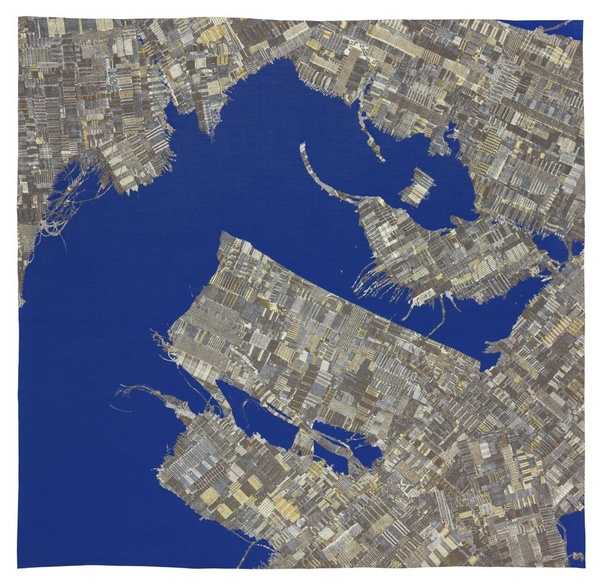Last week more than 250 galleries from 31 countries converged on Miami for Art Basel Miami Beach (ABMB) and its ever-growing entourage of satellite fairs, NADA and Untitled among them. In the opening days the mood among the more serious-minded was one of gratitude, in that ABMB had moved its vernissage to Thursday morning instead of the usual Wednesday evening, when in recent years it had become much like an alcohol-fuelled version of Pamplona’s running of the bulls.
Noted approvingly, for the most part, the fair’s Kabinett sector (for 10 years a means to give galleries a place to display their curatorial strengths) was smartly integrated this year throughout the fair, with participating galleries creating small annexes to their booths. Lehmann Maupin took full advantage of this by showcasing Teresita Fernández’s striking Rorschach (2013–14), a golden landscape sculpture reflected every which way in its obsidian-like low pedestal, along with companion wall pieces and tabletop sculptures. Rorschach sold to a private collector barely an hour into the fair’s preview. Crowds were also cramming the booth of Berlin-based Galerie Thomas Schulte’s Kabinett contribution to watch Robert Wilson’s mesmerisingly glacial video-portraits of three master paintings from the Louvre’s collection, several starring Lady Gaga, most memorably as the figure in Jacques-Louis David’s The Death of Marat (1793).
Among the most bustling booths were New Yorker Jack Shainman’s with its centerpiece, Nick Cave’s Hustle Coat – a cheap trench coat lined with bling; and Sadie Coles HQ, with its unique micro-climate of 1,080 plaster raindrops by Urs Fischer entitled Small Rain (2013). In the booth of Berlin’s Neugerriemschneider gallery, Pae White’s newest works resembled cityscapes seen from an airplane, but in fact, White digitises patterns from ancient kimonos and then uses a Belgian weaving technique to create metallic tapestries. Over at the NADA fair, White’s gold and porcelain tabletop sculptures of popcorn, shown by her hometown gallery China Art Objects in Los Angeles, sold out during the first hour of the preview and had a growing waiting list.
Drawing less attention was the Miami debut of the sector called Survey, dedicated to ‘precise art-historical projects’. Though given its mix of solo presentations, juxtapositions and thematic displays, the term ‘precise’ seemed precisely imprecise as used here. Nevertheless the 13 galleries gave some welcome context. At the booth for Vienna’s Charim Galerie were two rare spin paintings from the 1960s by Alfons Schilling, one of the early representatives of Action Painting; under the same cavernous roof, someone who may or may not have ever heard of Schilling (or Annick Gendron) could have been buying a painting by Damien Hirst made by similar processes, from some 30 years later.
Prospective buyers arrived so early the morning of NADA’s preview that the fair apparently opened a quarter of an hour ahead of schedule to prevent the crowd from spilling onto Collins Avenue. Krysta Eder, director of New York gallery the Hole, had to body-block the work of Wisconsin-based artist Gabriel Pionkowski, who deconstructs canvases, colourfully hand-paints each thread and then impeccably reweaves them on a loom. Pionkowski’s most arresting piece sold for $8,500 right as NADA opened, yet a stream of prospective buyers queried Eder deep into the afternoon about the waiting list. A more subtle standout at NADA was the booth exploring perversions of the tropical from the Guatemala City-based gallery Proyectos Ultravioleta.
At Untitled, which prides itself on its careful curation (gallerists apply and pitch the artists and artwork for Untitled’s curatorial team to approve), everything felt tastefully buyable; there was a lot that seemed both beautiful and conceptual, and nothing too uncomfortable or challenging (other than Jamaican artist Ebony G. Patterson’s installation of fabric-covered and fringe-trimmed coffins at the Chicago-based gallery of Monique Meloche). There was much wall-friendly work with a lot of whites and neutrals, a lot of graphics and linearity, with what the ‘decorati’ like to call ‘pops’ of bright colour. Worth noting were Dustin Yellin’s very recent series of layered glass and acrylic square and rectangular sculptures at Los Angeles’ Richard Heller Gallery. One of Untitled’s most photographed pieces was Spanish artist Guillermo Mora’s large-scale sculpture cr_O_ma 2013, constructed from rainbow-hued, hinged wood planks. It is boldly designed, according to his Madrid-based gallery Formatocomodo, to ‘surround the museum for which the piece has been created’, but until such time is also pliable enough to stash into a collector’s more modest quarters.
Published online 10 December 2014
